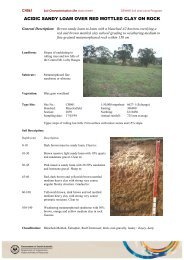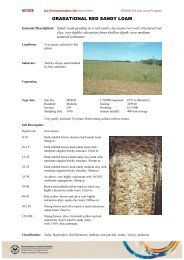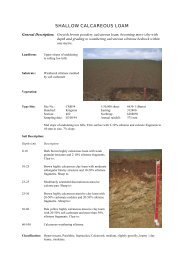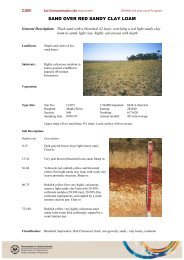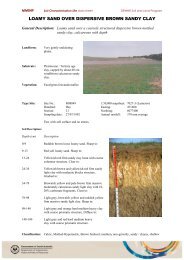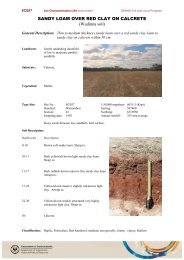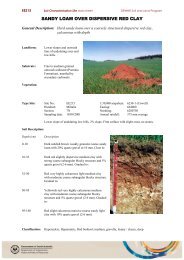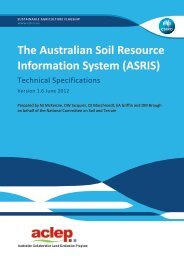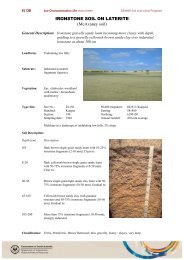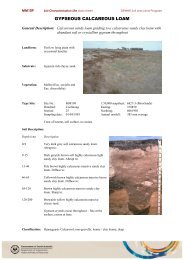Title: Atlas of Australian Acid Sulfate Soils Custodian: CSIRO ... - asris
Title: Atlas of Australian Acid Sulfate Soils Custodian: CSIRO ... - asris
Title: Atlas of Australian Acid Sulfate Soils Custodian: CSIRO ... - asris
You also want an ePaper? Increase the reach of your titles
YUMPU automatically turns print PDFs into web optimized ePapers that Google loves.
d Extratidal 11 flats (0.8) ASS 1 generally within upper 1 m.<br />
NON-TIDAL ZONES<br />
Floodplains<br />
e Floodplains < 2 m AHD 12 (0.8)<br />
ASS 1 , generally within upper 1 m. Grasslands, reedlands and wetland forests (e.g.<br />
Melaleuca, Casuarina). Includes backplains, backswamps and interbarrier swamps.<br />
f Floodplains 2 - 4 m AHD 12 (0.7)<br />
ASS 1 , generally below 1 m from the surface. Generally wetland forests (e.g. Melaleuca,<br />
Casuarina). Includes plains and levees.<br />
g Floodplains > 4 m AHD 12 (0.7)<br />
ASS 6 , generally below 3 m from the surface. Generally forests. Includes plains and levees.<br />
NON-TIDAL ZONES<br />
Sandplains and dunes in coastal 15 landscapes<br />
h Sandplains and dunes, 10 m AHD 12 (0.7) ASS 1 , generally below 1 m from the surface. Heath, forests. Mainly Pleistocene.<br />
Inland (i.e. not coastal 15 ) landscapes (> 10 m AHD 12 ) in wet / riparian areas 13 associated with:<br />
k Subaqueous material in lakes 14 (1.0) ASS 1 material and/or MBO 4<br />
l Organosols (0.8/0.05) ASS 1 generally within upper 1 m in wet / riparian areas with Organosols (Isbell 1996)<br />
m Hydrosols (0.8/0.1/0.05) ASS 1 generally within upper 1 m in wet / riparian areas with Hydrosols (Isbell 1996)<br />
n Sodosols, Chromosols and Dermosols ASS 1 generally within upper 1 m in wet / riparian areas with Sodosols, Chromosols and<br />
(0.5/0.05)<br />
Dermosols (Isbell 1996)<br />
o Vertosols (0.5/0.05) ASS 1 generally within upper 1 m in wet / riparian areas with Vertosols (Isbell 1996)<br />
p Calcarosols (0.5/0.05) ASS 1 generally within upper 1 m in wet / riparian areas with Calcarosols (Isbell 1996)<br />
q Kandosols, Ferrosols, Tenosols,<br />
Rudosols, Podosols and Kurosols<br />
(0.5/0.05)<br />
ASS 1 generally within upper 1 m in wet / riparian areas with Kandosols, Ferrosols, Tenosols,<br />
Rudosols and Podosols (Isbell 1996)<br />
SUBSCRIPTS TO CODES<br />
(a) Actual ASS (AASS) 3<br />
Actual acid sulfate soil (AASS) = sulfuric material (Isbell 1996, p.122.)<br />
(p) Potential ASS (PASS 2 ) Potential acid sulfate soil (PASS) = sulfidic material (Isbell 1996, pp. 121-122)<br />
(m) MBO 4 , significant occurrence Monosulfidic Black Ooze (MBO) is organic ooze enriched by iron monosulfides (Bush et al. 2004).<br />
CONFIDENCE LEVELS (after Isbell 1996) Map polygon contains ASS, and:<br />
(1) All necessary analytical and morphological data are available<br />
(2) Analytical data are incomplete but are sufficient to classify the soil with a reasonable degree <strong>of</strong> confidence<br />
(3) No necessary analytical data are available but confidence is fair, based on a knowledge <strong>of</strong> similar soils in similar environments<br />
(4) No necessary analytical data are available and classifier has little knowledge or experience with ASS, hence classification is provisional<br />
OPTIONAL DESCRIPTORS<br />
f Fill materials<br />
h Hypersaline or gypseous horizons<br />
generally within 10 cm <strong>of</strong> the surface<br />
o Organic material<br />
n Self neutralising sulfidic material<br />
D Deep variant ASS<br />
P Pleistocene<br />
e Excavation feature<br />
d Desiccation cracks<br />
c Clayey material<br />
s Sandy material<br />
Undifferentiated fill material between 0.5m and 3 m thick, overlays ASS materials<br />
Hypersaline is equivalent to hypersalic as defined by Isbell (1996, p 47). Saltpans are common, average<br />
annual rainfall is generally < 400 mm, and the vegetation is dominated by halophytes (samphire, salt<br />
bush, blue bush) Gypseous is equivalent to gypsic as defined by Isbell (1996, p 114).<br />
Organic, as for organic materials defined by Isbell (1996, p 116; including sapric, and hemic material).<br />
Average annual rainfall is generally > 400 mm, and the vegetation is mainly grassland (e.g. saltwater<br />
couch, Phragmites)<br />
Self neutralising sulfidic material (PASS material) confirmed by field observation, sampling and<br />
laboratory analyses (commonly carbonate rich).<br />
ASS generally deeper than the depth specified in the legend<br />
Based on dating or stratigraphic evidence<br />
Excavated drains, canals, lakes, dams and other water accumulating structures within which modern<br />
ASS forms.<br />
Desiccation cracks usually expressed as irreversible trans-horizon polygonal cracks, <strong>of</strong>ten with coarse<br />
columnar ped structures, which usually forms as a result <strong>of</strong> desiccation and dewatering <strong>of</strong> clayey or<br />
peaty subaqueous soils and sediments during drying and wetting cycles.<br />
Clayey material (>35% clay; light, medium and heavy clay)<br />
Sandy materials (sand, loamy, sand, clayey sand texture groups)<br />
Examples (i): Ae (p1) h Polygon with high probability <strong>of</strong> ASS occurrence in a floodplain < 2 m AHD, with potential ASS<br />
confirmed by analytical and morphological data, that also contains a hypersaline and gypsic horizons.<br />
(ii): Bx (a2) f - Polygon with low probability <strong>of</strong> ASS occurrence in a disturbed environment with actual ASS. Analytical<br />
data are incomplete but are sufficient to classify the soil with a reasonable degree <strong>of</strong> confidence. The actual ASS is now<br />
covered by 0.5 to 3 m <strong>of</strong> undifferentiated fill material.<br />
1 <strong>Acid</strong> <strong>Sulfate</strong> <strong>Soils</strong> (ASS) are all those soils in which sulfuric acid may be produced, is being produced, or has been produced in amounts that have a<br />
lasting effect on main soil characteristics (Pons 1973). This general definition includes: (i) potential, (ii) actual (or active), and (iii) post-active ASS,<br />
three broad genetic soil types that continue to be recognized (e.g. Fanning 2002). ASS form in coastal, estuarine, mangrove swamp and marsh<br />
environments because these waterlogged or highly reducing environments are ideal for the formation <strong>of</strong> sulfide minerals, predominantly iron pyrite<br />
(FeS 2 ). Soil horizons that contain sulfides are called sulfidic materials (Isbell 1996; Soil Survey Staff 2003) and can be environmentally damaging if<br />
exposed to air by disturbance. Exposure results in the oxidation <strong>of</strong> pyrite, with each mole <strong>of</strong> pyrite yielding 4 moles <strong>of</strong> acidity (i.e. 2 moles <strong>of</strong> sulfuric<br />
acid). This process transforms sulfidic material to sulfuric material when, on oxidation, the material develops a pH <strong>of</strong> 4 or less (Isbell 1996); note that<br />
a sulfuric horizon has a pH <strong>of</strong> 3.5 or less according to Soil Survey Staff (2003).<br />
1. <strong>Acid</strong> sulfate soil (ASS) may include PASS or AASS + PASS.




